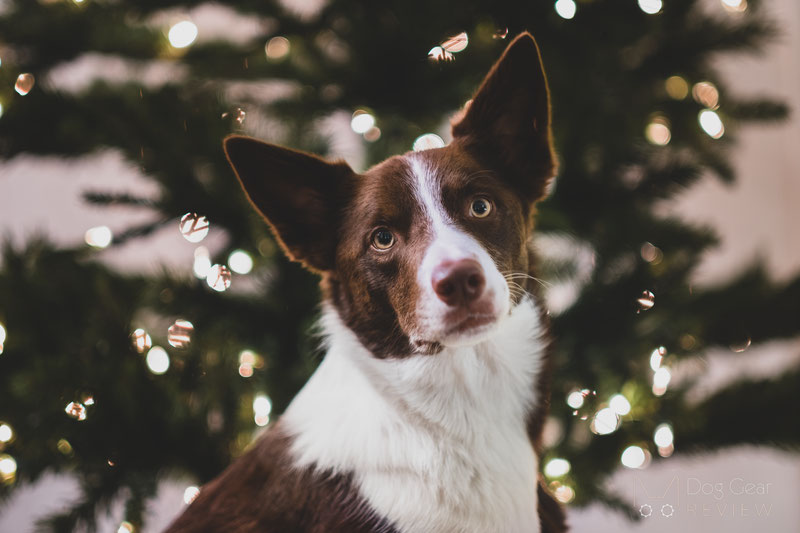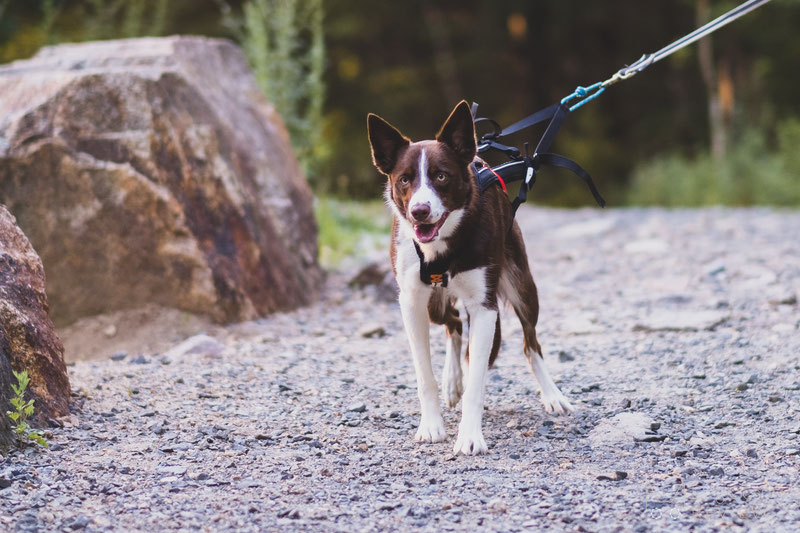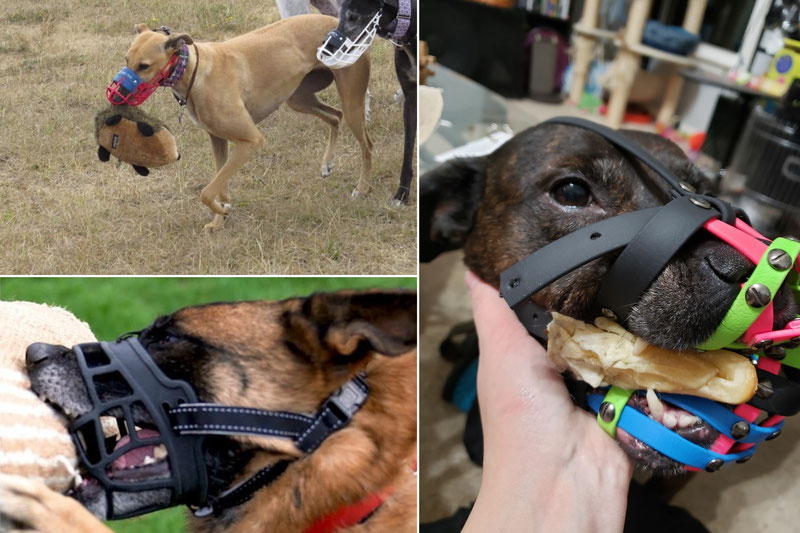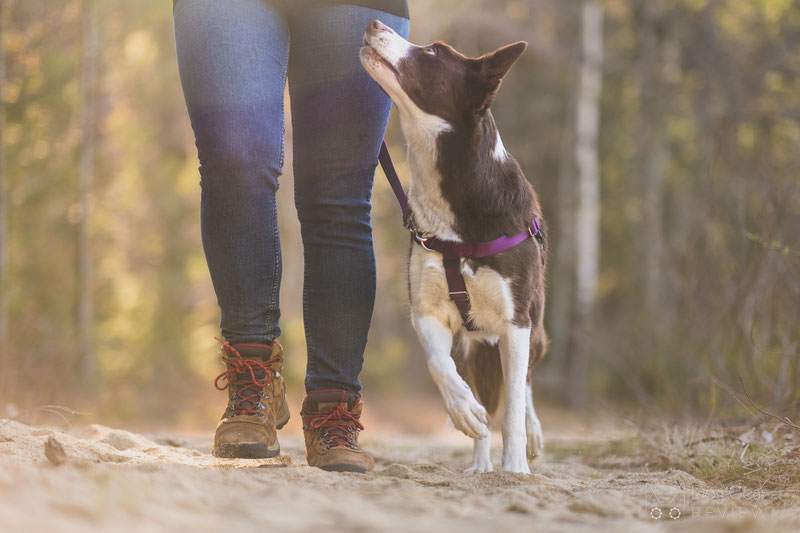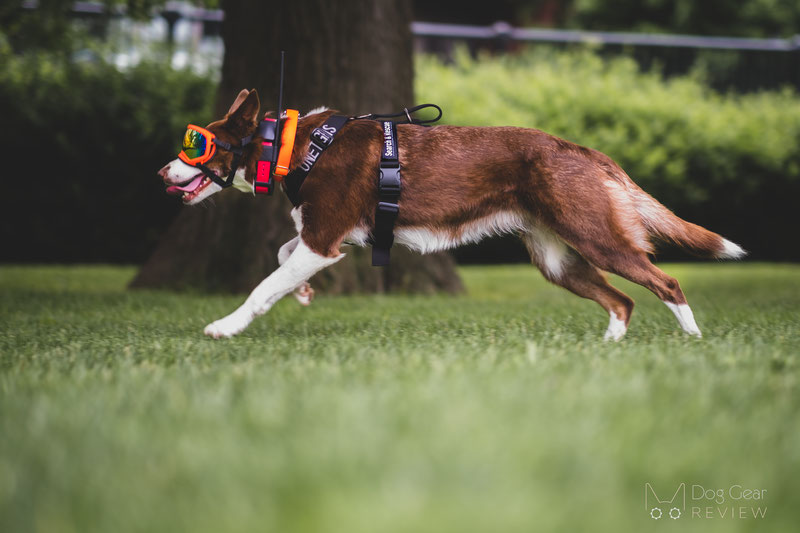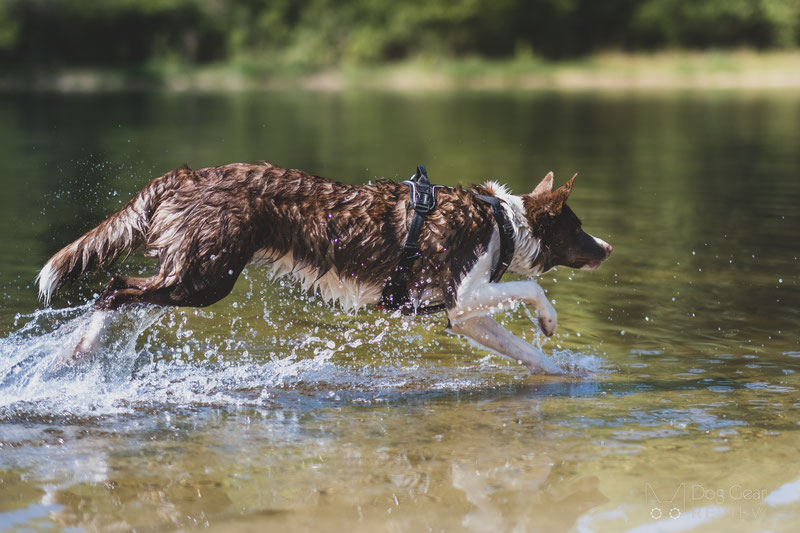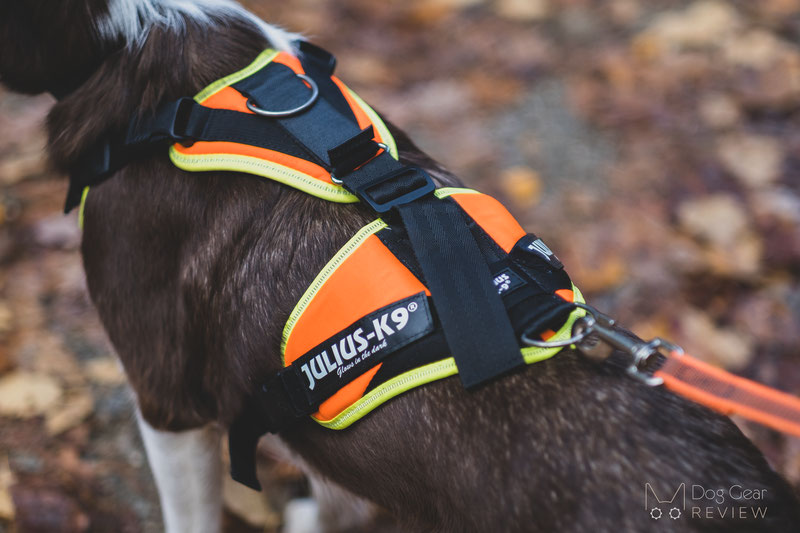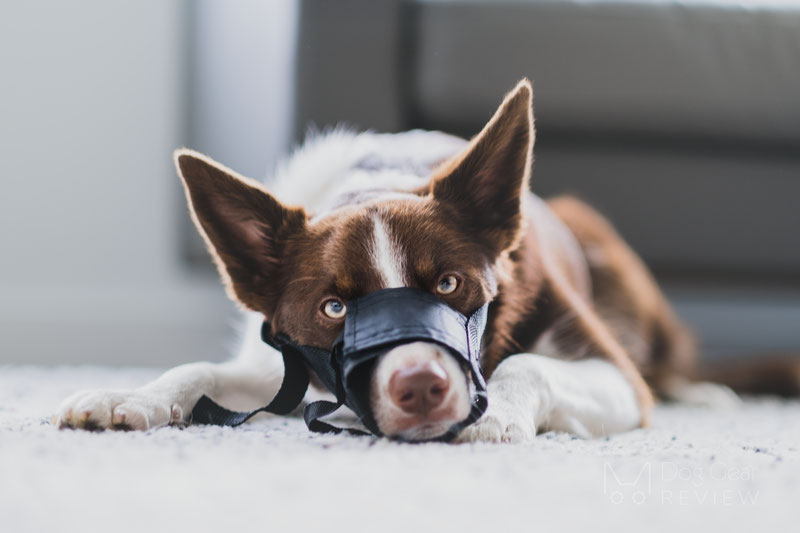Where did this idea came from?
We are testing dog coats for a few years now - by the end of this season, we will have 18 coat reviews on our website! When reviewing, we usually pay attention to quality, material, durability, waterproofness, and freedom of movement, but the most important aspect, warmth, is hard to evaluate. Since Mia can’t tell us if her back or chest is still cold while wearing the coat, we got a thermal camera to check them out! ;)
The method
The idea was straightforward: if the coat insulates well, the outside of the jacket should be cool; if it doesn’t, it lets the dog’s body heat through. The warmer the coat looks on the thermal camera’s photo, the colder the dog feels on that area.
In the hope of making the results comparable, we tried to keep the coats at the same temperature before putting them on Mia. We also put Mia back in the car between coats so she can warm up. We left all coats on her for at least 5 minutes before taking photos to give them time to warm through. We also took all images in the evening so the sun wouldn’t have a chance to warm up the coats’ outer layer.
Well, this sounded perfect on paper. It would be great if we could clearly tell you that one coat is much better than the other just based on these photos, but this project turned out to be a little more complicated than imagined. As we started taking and analyzing the first images, we realized many flaws in our experiment. There were outside factors that were very hard to eliminate - like wind and Mia’s changing body temperature while running around more while wearing one coat and less while wearing others.
The thermal image also doesn’t show that having a windbreaker layer on the dog can make a big difference in “feels-like” temperature. A thinner fleece vs. a wind-proof layer might warm through the same way on a thermal image, but the latter will still provide better protection in strong wind.
The coat design is also important because one covering mostly the back of the dog will capture less heat since the dog’s neck and back already insulates well. Some coats are meant to be a snug fit, while others are roomier. Latter can be useful because the air under or in the coat will insulate, but with a loose jacket, the cold air would have an easier time getting under it on a windy day. If you have a loose coat that doesn’t touch parts of the dog (usually the end of the back), it falsely shows up as a perfectly insulating layer when the truth is that the heat just comes out without being trapped in the material there. Another thing to keep in mind is that dogs with a fluffy coat also have air between their hair, which helps in insulation. Putting a snugly fitting coat on them might make them feel colder altogether because although you added a layer over their fur, you pushed their fur down, removing their natural way of protection against cold.
In the picture below, you see Mia without a coat. Of course, this photo would be different for dogs with different build or hair length/type. In general, we can say that the legs, ribs, and tummy are the parts where dogs lose most of the heat. They also lose heat on their face and ears, but we will ignore that for this article’s purpose.
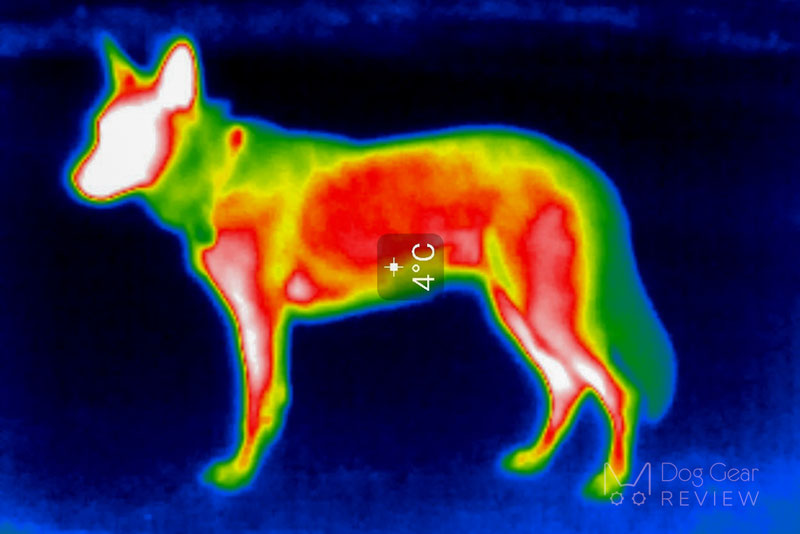
When picking a coat, it’s good to remember that keeping the joints and main muscle groups warm helps to prevent injuries. This is especially important if you do a sport with your dog where they have to wait for their turn and then run right after - like agility or flyball. In these cases, having a coat covering most of the shoulder and hips can be very helpful. Older dogs or dogs with hip problems can also benefit from a jacket nicely covering the hip area.
Before we start talking about each coat, keep in mind that we didn’t use a high-end, professional heat camera. Unfortunately, the temperatures showing on the photos are not correct so just ignore them. In general, they show +5-10 Celsius more than the actual surface is, and it is not accurate enough to show small differences consistently on different sections of the coats.
We also tried to set the camera’s scale to the same for the photos hoping that the coloring would be more comparable on different images, but it wasn’t manageable all the time due to changing temperatures even during one session and especially between different days. Remember that we checked 16 coats with the warm-up time between them, so it was challenging to get this done consistently, especially on days when the cold hurt even through many layers.
We think the photos still show exciting insights of the insulating effects of different designs and materials, but we had a hard time creating entirely comparable images. We also tried to explain the results as best we could, but we are by no means experts on analyzing heat images. If you have a different explanation for some of our findings, we are absolutely open to a discussion!
Let’s look at the coats!
We checked all the coats that we reviewed this season and grabbed a few we received previously. We will explain the materials used in the jacket first and have a clear photo of the design for comparison. Check the “normal” image first to see where the coat is a snug or lose fit on the dog because this will help understand the thermal photos.
Non-stop Dogwear Glacier Jacket
The Glacier Jacket has Synthetic ECO insulation and a 3L Polyester shell with 2.5L Polyester ripstop with a 2.5 layer membrane. It is a thick but “puffy” coat meaning that it looks bulky on the dog, but you can easily pack it by pressing the air out of it. The Non-stop Dogwear’s coats were designed to fit a long pulling harness under them comfortably, so they meant to be a little looser around the dog. This is particularly visible on the back of the coat: it provides extensive coverage, but the cold air still easily gets under the coat’s end even though the elastic loops around the back legs keep it from sliding around.

The air in and under the coat actually helps with insulating. This shows when you look at the midsection where the chest strap pushes the jacket down, forcing the air out. The thermal images show that the other sections of the coat insulate very well - or it actually shows that the heat doesn’t go through the jacket. As we mentioned above, it’s also possible that some heat just comes out on the sides due to the looser fit, but regardless, this coat seems to do a reasonably good job keeping the dog warm both around the chest, where it’s snugger and on the back where it’s looser. The coat also has excellent coverage protecting most areas where dogs tend to lose heat.
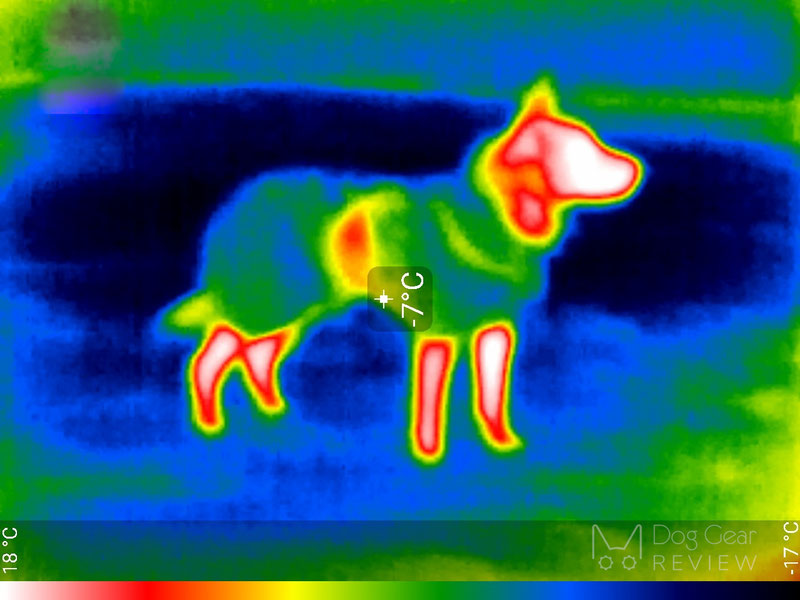
We already reviewed this coat so if you want to learn more about it, check it out on this link!
Non-stop Black Jacket Light
The Black Jacket Light has a similar design to the Glacier Jacket but is less “puffy” and covers less of the back legs. The insulation used is Primaloft with a ripstop cover. This coat doesn’t have elastic loops to hold the end down, so the cold air has an easier time getting under the material on a windy day.
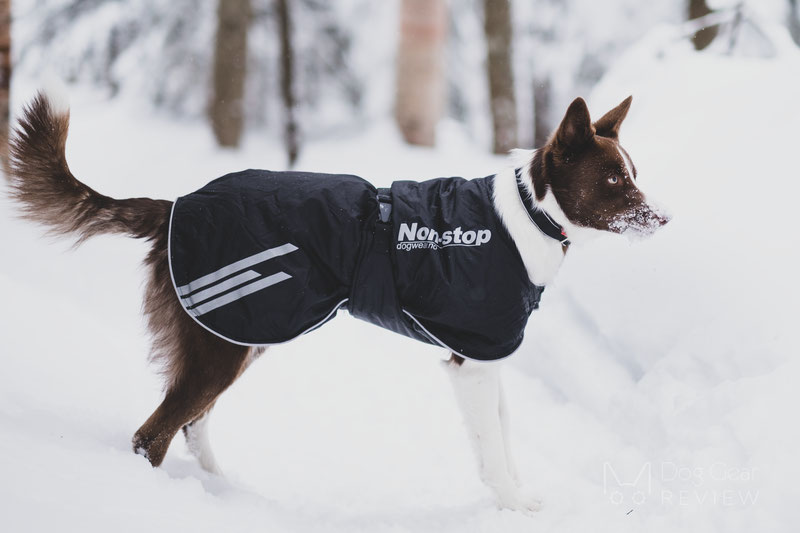
The photo below was shot on the same day as the Glacier Jacket above. You can see that the coat doesn’t insulate as much as the Glacier jacket, but it still covers most of the shoulders, hips, and back. The air’s insulating effect and the lack of it also show on this thermal image under the coat’s belly strap.
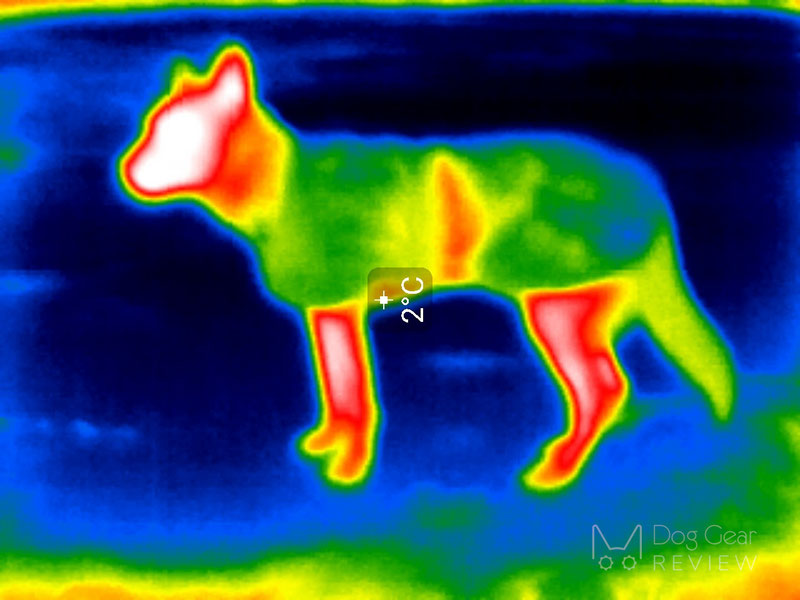
We already reviewed this coat so if you want to learn more about it, check it out on this link!
Non-stop Dogwear Blest Jacket
The Blest Jacket is a very packable, ultralight coat with Primaloft insulation and ripstop shell on both sides. This coat isn’t “puffy” almost at all, which means there isn’t much air in it to insulate. In material, this is very similar to the Black Jacket, but the coverage of the coat is much bigger. There is also an additional windbreaker that you attach to the belly section to protect male genitals in freezing temps. This coat was made with sleddogs in mind, and our thinking is that it is mostly designed to add a layer of wind protection without too much insulation because you don’t want active dogs to overheat while running either.
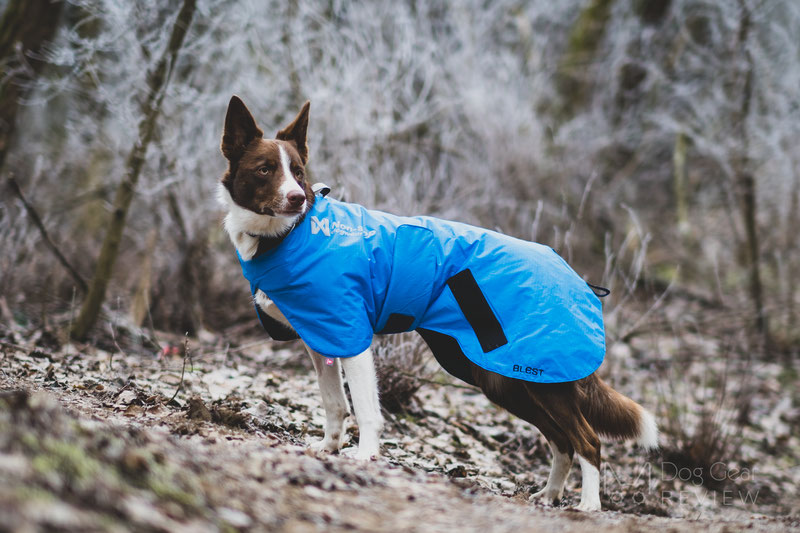
As you see on the thermal photo below, it doesn’t insulate as much as the Glacier jacket - especially under the section where the belly strap is tightened. I also left the midsection looser when I used this coat above their Freemotion harness, which is probably better insulation-wise.
The colder-looking back section of the coat is a loose fit (no elastic strap around the back legs to keep the jacket down), so I assume it doesn’t warm up because the warm air doesn’t stay under it. You can compare it to the shoulder area, where the coat was a snug fit.
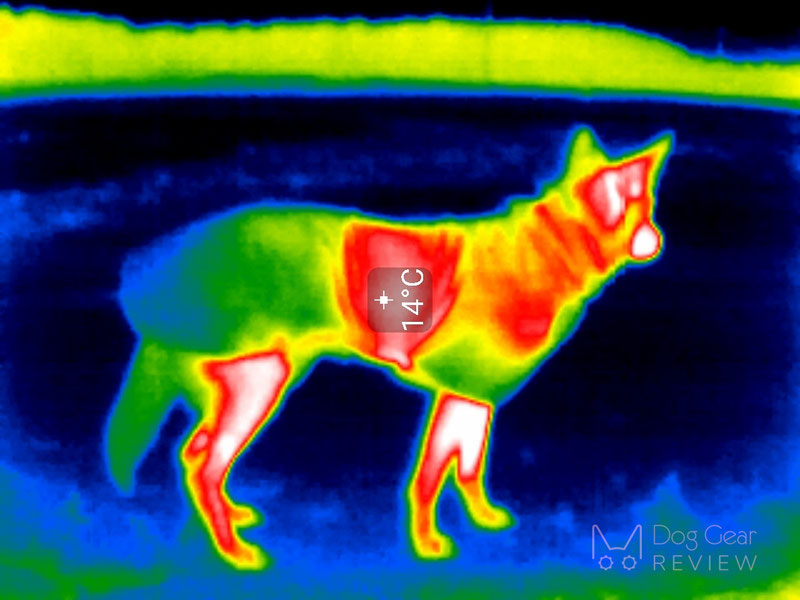
We already reviewed this coat so if you want to learn more about it, check it out on this link!
Non-stop Dogwear Beta Raincoat
Just for the comparison, we also checked Non-stop Dogwear’s raincoat, which is a super-thin coat that we even used in summer storms. It has a polyester shell and a breathable membrane inner layer. This coat has a loop around the back legs to keep it in place and provides excellent coverage. It’s basically like the Glacier Jacket without insulation layers.

The thermal imagine shows that thin material lets the heat through basically everywhere where the coat is touching the dog. Where the coat seems to insulate, those are actually the sections that stay cool because they are loose. The thin material also loses the heat fast, so once the coat isn’t touching the dog, it cools back down in seconds.
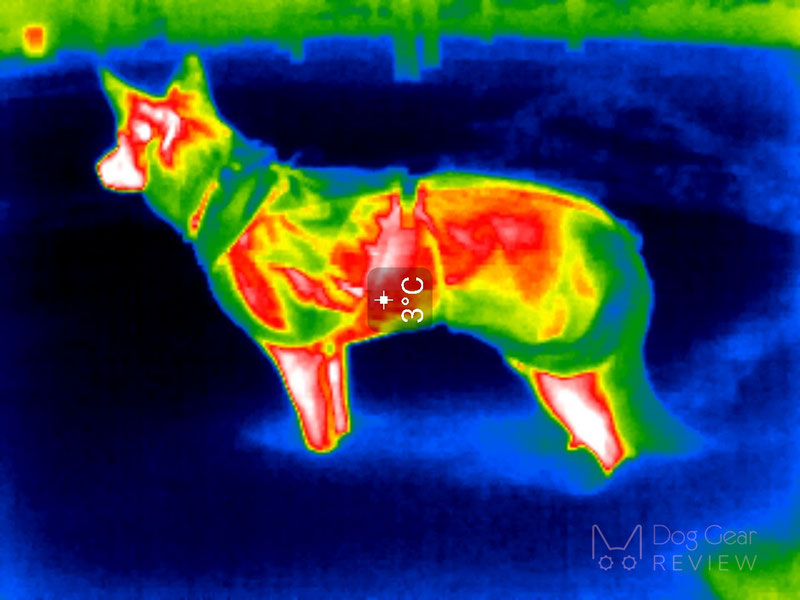
We already reviewed this coat so if you want to learn more about it, check it out on this link!
Voyager-K9 Apparel Winter Coat
The Voyagers Winter Coat was very interesting to check with the thermal camera due to the two different materials used. The chest and “hood” parts are made of fleece, while the back of the coat has a Polartec polar fleece lining with a Taslan nylon outer layer. This is a snugly fitting coat without any puffy/bulky feeling. This also means that there is basically no air between the layers for insulation.
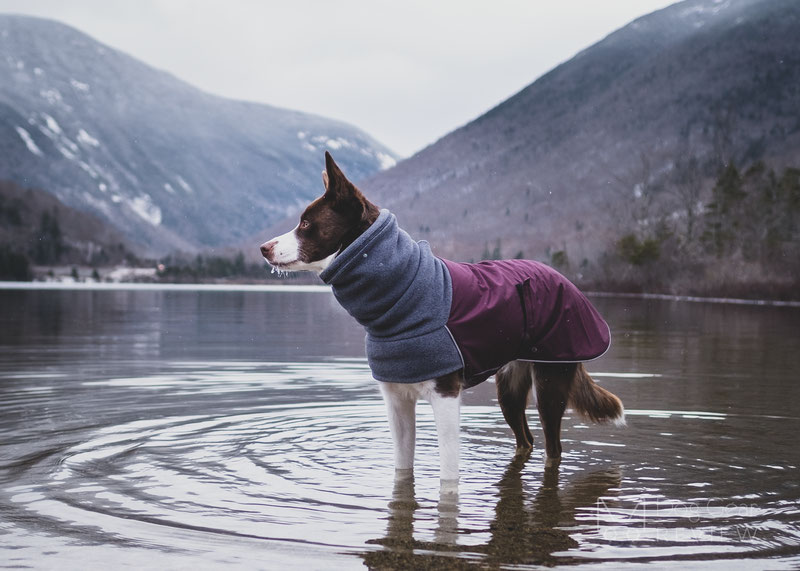
The photo below clearly shows where the fleece section ends and where the more insulating back area starts. The snugly fitting midsection lets through some heat but much less than the fleece front. The end of the coat is a looser fit, and it’s an example again for showing up on the thermal image as an almost perfect insulating layer while it actually just doesn’t touch the dog to warm up and lets the air in.
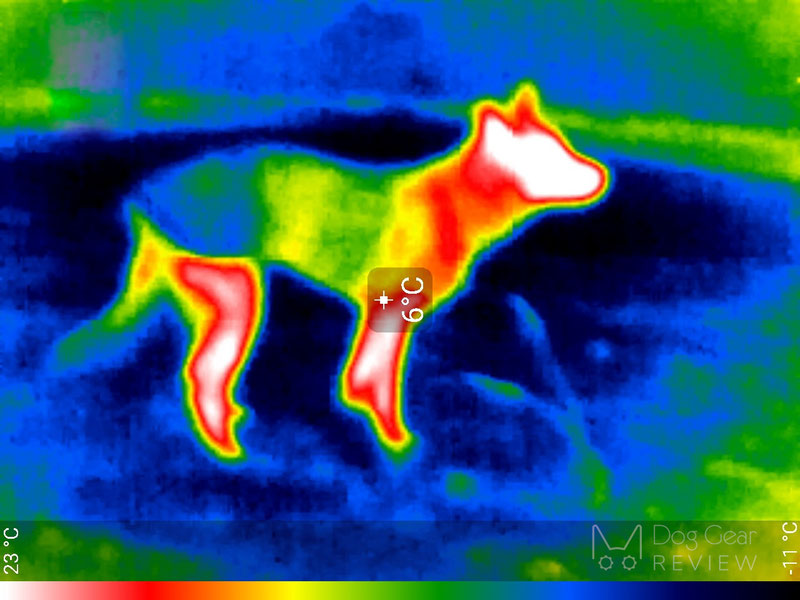
We already reviewed this coat so if you want to learn more about it, check it out on this link!
Voyagers-K9 Apparel Tummy Warmer
The Voyagers-K9 Tummy Warmer is made from the same 200 weight Polartec Polar Fleece fabric used for the chest part of the Winter Coat above. It has a wide belly strap to create a snug fit on the midsection of the dog.
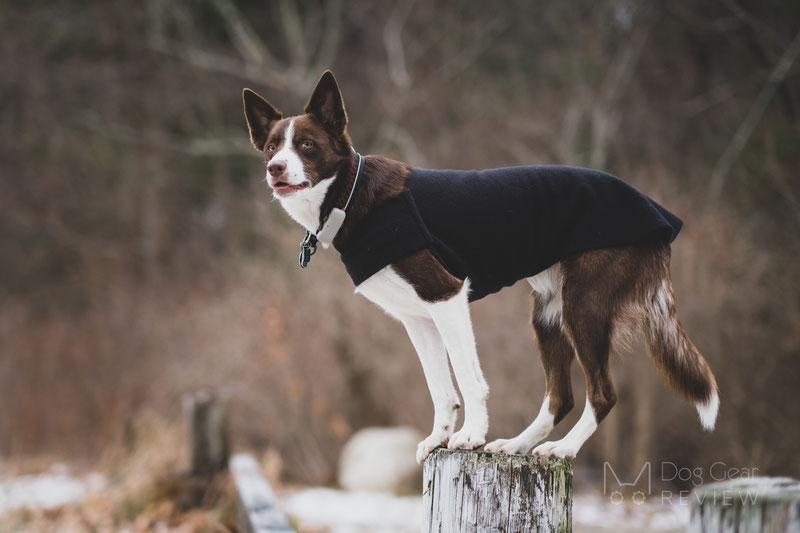
This coat’s thermal image confused us so much that we went back to re-take the photos on three different days but got the same result. For whatever reason, it does look like it insulates better than the neck/hood section of the Winter coat, which doesn’t make sense since it is made from the same material.
The only explanation we came up with is that the smaller chest section might not be as good at retaining heat as the winter coat’s thicker and bigger hood area. There may be a more reasonable explanation, so if someone has more knowledge in thermodynamics, don’t hesitate to reach out to us!
Besides the mystery of the chest section, the other parts of the coat show up as expected: the jacket warms through, where it is snug around the dog while it’s cool on the loose back section. Since polar fleece doesn’t have much air between the layers, the double layer created by the broad belly strap insulates better.

We already reviewed this coat so if you want to learn more about it, check it out on this link!
Canelana Thermo Coat
The Canelana Thermo Coat is very thick. It has a merino wool lining inside and a wind- and waterproof, soft-shell outer layer. The coat is also designed to have multiple layers over the mid-section of the dog for added insulation. All the Canelana coats are excellent in covering the back end of the dog - there is an elastic loop to tighten the back part around the hips. This keeps the coat in place very nicely and prevents the wind from getting under the back section.
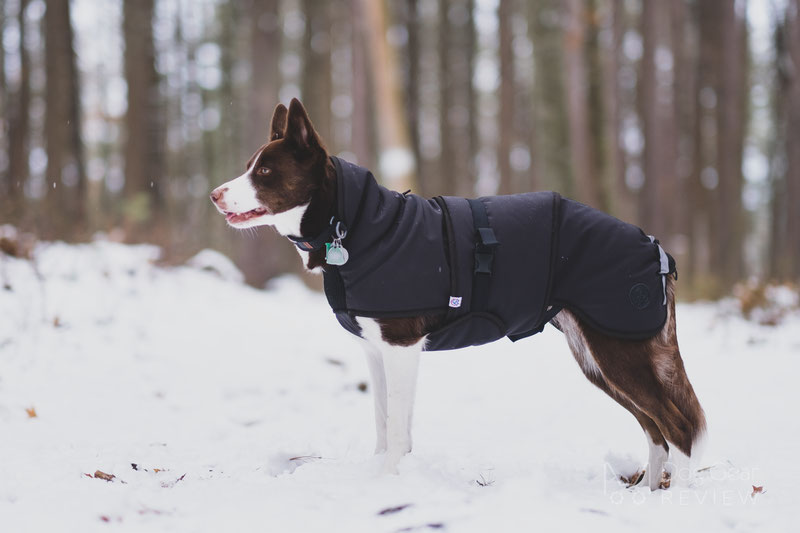
As you see below, the Thermo coat evenly insulates everywhere, even under the straps and the loop & hoop panels. With this coat, wool is the primary insulating material instead of air, eliminating the trouble of losing insulation under overlaying sections as we saw it with puffier coats.
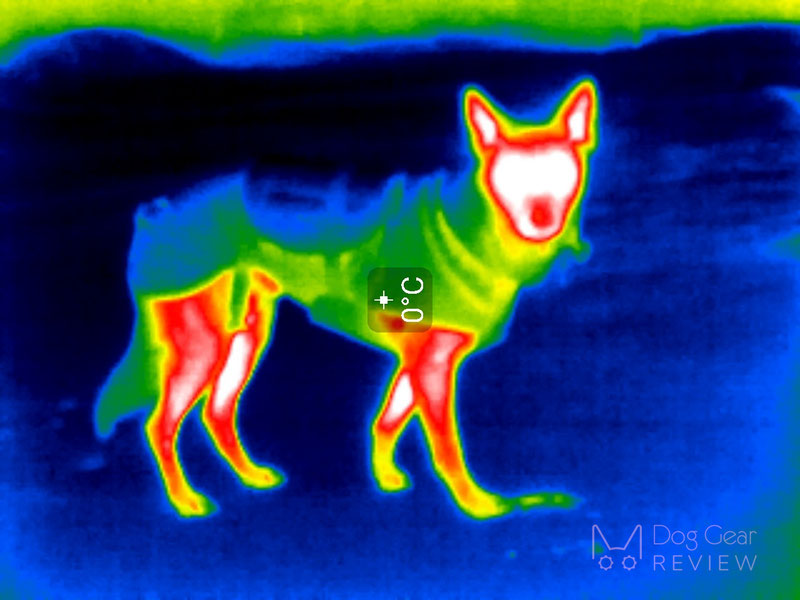
We already reviewed this coat so if you want to learn more about it, check it out on this link!
Canelana Sporting Coat
The Canela Sporting Coat is a much thinner coat in Canelana’s product line. It has a light ripstop outer layer, thin wool felt in the middle, and a perforated lining inside. An exciting feature of this coat is that it has “inner pockets” for heating packs/warmers over the shoulders and back/hips for dogs that need extra heat to keep the joints and muscles warm (we haven’t utilized those when taking the images).
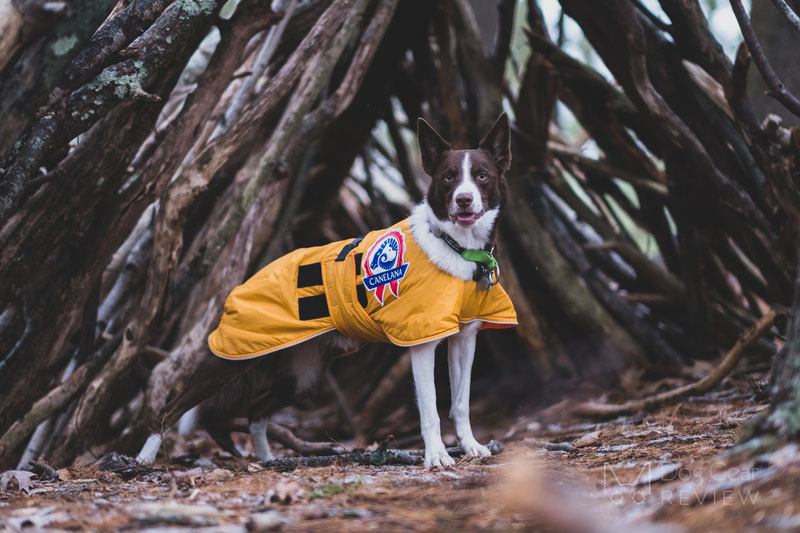
We were actually surprised how well this coat looked on the thermal image compared to how thin it is. It seems having the wool insulating layer does make a difference. This coat has a little “airier” design than their Thermo coat, so the belly straps and velcro panels show up on the side where there is not much air under it to insulate. It is also a looser fit; you can see that the end of the back and the bottom of the front sections are loose, which can cause it to not warm through while it doesn’t tell us much about insulation. It’s also worth noting that this coat insulates very evenly: there is only a small difference between the snugly fitting shoulder section vs. the more loosely fitting hip area.
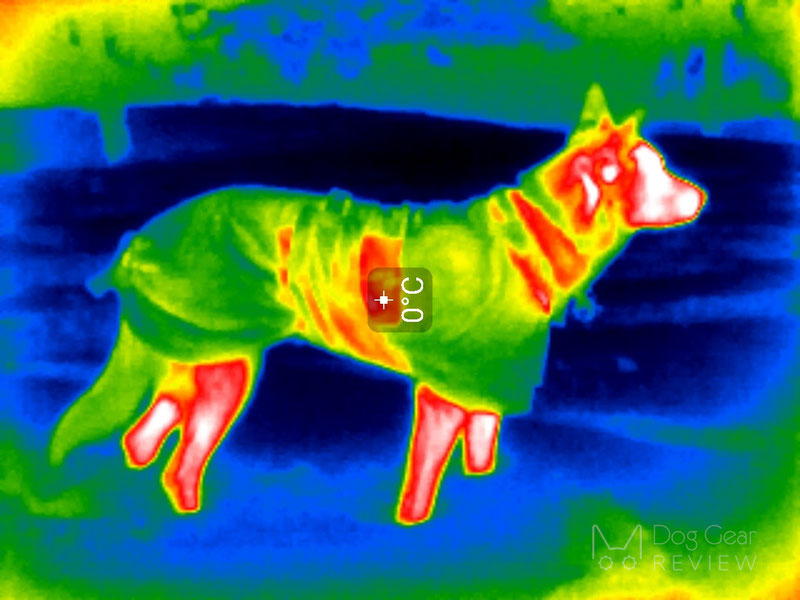
We already reviewed this coat so if you want to learn more about it, check it out on this link!
Canelana Ambassador Wool Coat
Canelana has two wool coats meant to be used while the dog is waiting in the car between training turns. The Ambassador Wool Coat is the same design as their Thermal Coat but without the soft-shell outer layer. This coat is excellent to keep the dog warm indoors, but it doesn’t have an outer layer to protect the dog from the wind. Wool absorbs moisture without becoming cold, and in addition, wool has excellent breathability that helps regulate body temperature.

Wool has tiny air pockets that create a thermal barrier, but they are harder to “press” out than designs where a puffy coat has significant air layers in the coat. While the latter coats showed less insulation under overlapping layers, thermal images of wool coats show the opposite: more layers around the dog means more insulation.
The thermal image is a little harder to evaluate without a wind-proof outer layer. It looks like warmth comes through the coat, which I can confirm: the coat feels warm while Mia is waiting in the car. At the same time, the coat warms through all around Mia, so even her back feels warm and toasty when I remove it.
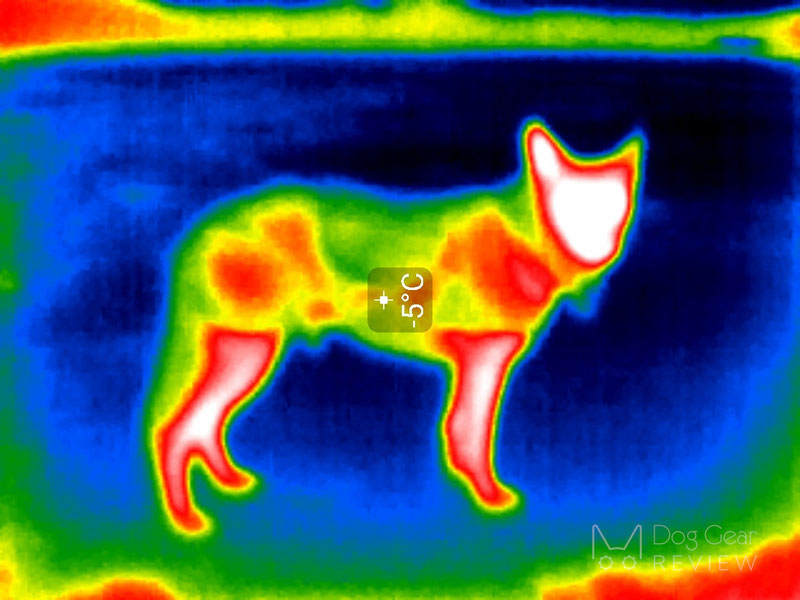
We already reviewed this coat so if you want to learn more about it, check it out on this link!
Canelana Lana Wool Coat
The Lana wool coat is the same design as the Ambassador Coat but with a thinner wool layer. Again, this wasn’t meant to be used mainly for outdoor adventures.
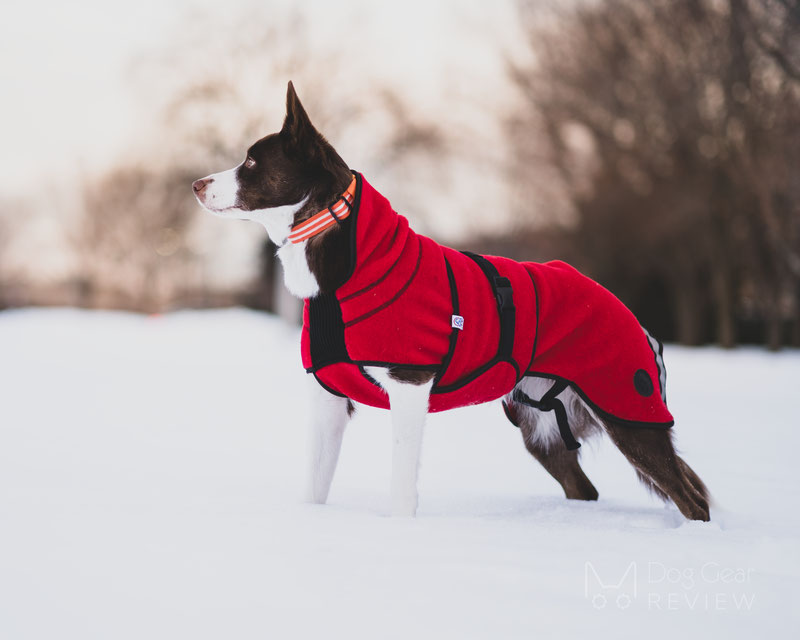
As expected, it behaves like the previous coat while showing more heat coming through the material due to the thinner layer of wool.
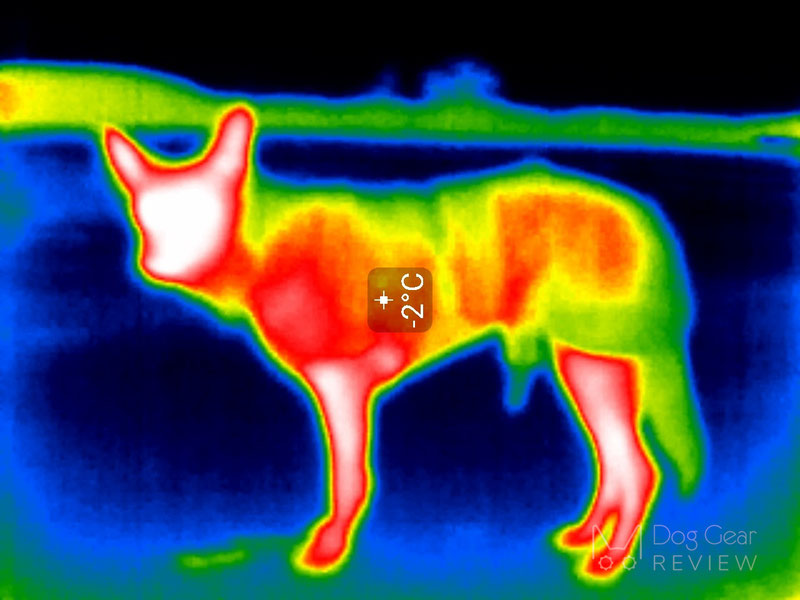
(Review status: we are still testing this coat, review is coming before the end of the season!)
Kurgo Loft Jacket
The Kurgo Loft Jacket is a very minimalistic coat. It has a Microtomic Ripstop material and polytech fill. It doesn’t mean to cover the dog’s back all the way; just keep the shoulders and chest warm.

The coat has a “dense” material without any puffiness, and it is more “rigid,” so it doesn’t touch Mia on the areas that show up on the thermal image as dark blue. This means it also has air under it, which insulates, but you can see how the material itself lets some heath throw on the back where it’s touching her.
The thermal image also points out how this design doesn’t protect many areas where dogs lose heat, so this coat is probably better used for mild days than freezing temps with a wind chill.

We already reviewed this coat so if you want to learn more about it, check it out on this link!
Csinieb Sport Jacket
The Sport Jacket is made from a neoprene material on the top with fleece lining and orange fleece on the sides. This is a custom-made, thinner coat for active dogs, which was designed for mid-season. Although it wasn’t meant to be a warm winter coat, we wanted to check it out as a comparison.
Neoprene is an interesting material: it has a cellular structure with nitrogen gas bubbles trapped inside, creating the insulating effect.
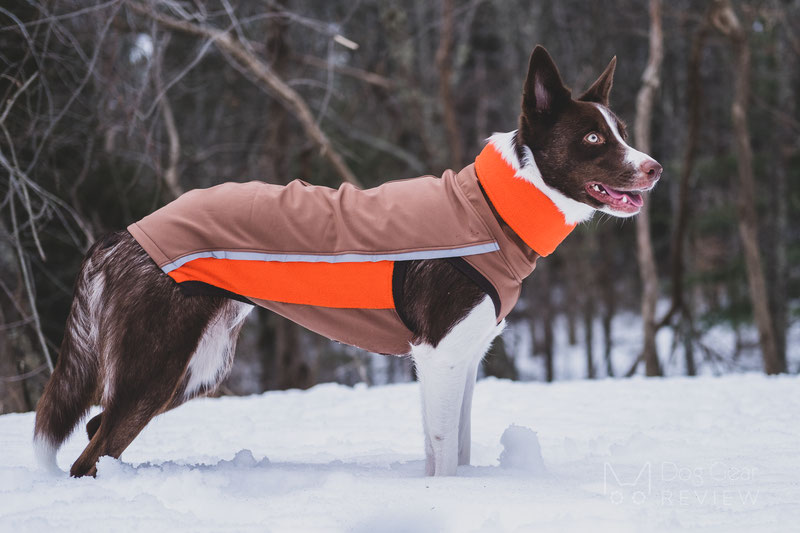
This thermal image is interesting because while it shows that the bottom fleece part insulates much less than the neoprene top part, the heat also comes through the top part where the coat is touching the dog. This is also a good example of a jacket that’s enough to provide a little extra warmth for active dogs but doesn’t insulate well enough to protect from the severe winter cold.

We already reviewed this coat so if you want to learn more about it, check it out on this link!
Summary
It was fascinating to write this article and see how coats can provide very different levels of protection against the cold. I used to think that if I want to keep Mia warm, I should adjust the coat’s belly strap to give a snug fit, but that seems counterproductive for puffy coats. I also intuitively knew that having a jacket with good coverage is essential, but it was interesting to see where dogs lose heat.
After going through all this analysis, I feel that it might make more sense for active dogs to use a coat with more significant coverage but less insulation. Many seem to think that thicker and warmer coats are always better, which is probably true for older dogs or those who are not as active in general, but if your dog runs around off-leash, you don’t want them to get too warm either. Instead of having one warm coat, layering up can also be a great option because you can adjust the insulation level as needed and create more of those air layers between coats.
Our goal with this article was to point out interesting aspects of different materials and coat designs’ insulating capabilities, so you have more factors to consider when choosing one. We can’t tell you which coat is better since it will all come down to your priorities and your dog’s needs.
If you have any questions or input, please reach out to us; we are always interested in further brainstorming on these findings! :)

